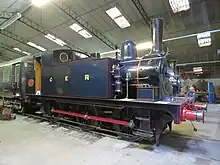GER Class S56
The GER Class S56 was a class of 0-6-0T steams designed by James Holden for the Great Eastern Railway. Together with some rebuilt examples of GER Class R24, they passed to the London and North Eastern Railway at the grouping in 1923, and received the LNER classification J69.
| GER Class S56 (and R24 rebuilt) LNER Class J69 | |||||||||||||||||||||||||||||||||||
|---|---|---|---|---|---|---|---|---|---|---|---|---|---|---|---|---|---|---|---|---|---|---|---|---|---|---|---|---|---|---|---|---|---|---|---|
 LNER 8625 (ex-7059, exx-GER 59) at Stratford locomotive depot, 28 September 1946 | |||||||||||||||||||||||||||||||||||
| |||||||||||||||||||||||||||||||||||
| |||||||||||||||||||||||||||||||||||
| |||||||||||||||||||||||||||||||||||
| |||||||||||||||||||||||||||||||||||
History
The Class S56 were a development of the Class R24, being almost identical, apart from higher boiler pressure and larger water tanks. Twenty were built in 1904 at Stratford Works.
| Year | Order No. | Quantity | GER Nos. | LNER Nos. | 1946 Nos. | Notes |
|---|---|---|---|---|---|---|
| 1904 | S56 | 10 | 51–60 | 7051–7060 | 8617–19, —, 8621, —, 8623, —, 8625–8626 | |
| 1904 | P57 | 10 | 81–90 | 7081–7090 | —, 8628–8633, —, 8635–8636 | |
All twenty passed to the LNER in 1923. Thirteen class J69 locomotives were lent to the War Department in October 1939,[2] of which five had been built as Class S56. They were sold to the War Department in October 1940,[3] where they were used on the Melbourne and Longmoor Military Railways.[2] The remaining locomotives were renumbered 8617–8636 in order of construction; however gaps were left where the locomotives sold to the War Department would have been. At nationalisation in 1948, the remainder passed to British Railways, who added 60000 to their number. Post-war withdrawals started in 1958, and by 1962 all had been retired.[4]
| Year | Quantity in service at start of year | Quantity withdrawn | Locomotives numbers | Notes |
|---|---|---|---|---|
| 1940 | 20 | 5 | 7054, 7056, 7058, 7081, 7088 | to WD 86, 87, 83, 80, 91 |
| 1958 | 15 | 5 | 68617–18/28/31–32 | |
| 1959 | 10 | 4 | 68625/29–30/36 | |
| 1960 | 6 | 1 | 68633 | |
| 1961 | 5 | 2 | 68619/23 | |
| 1962 | 3 | 3 | 68621/26/35 | |
Preservation

GER no. 87 (LNER 7087, 8633, BR 68633) has been preserved, initially at the Clapham Transport Museum,[5] and now at the National Railway Museum. It is currently on display at Bressingham Steam Museum.
References
- Aldrich 1969, p. 102
- Tourret 1995, p. 47
- Aldrich 1969, p. 103
- Aldrich 1969, pp. 124–125
- Aldrich 1969, p. 104
- Aldrich, C. Langley (1969). The Locomotives of the Great Eastern Railway 1862–1962 (7th ed.). Wickford, Essex: C. Langley Aldrich. OCLC 30278831.
- Tourret, R. (1995). Allied Military Locomotives of the Second World War. Abingdon, Oxon: Tourret Publishing. ISBN 0-905878-06-X.
- Ian Allan ABC of British Railways Locomotives, part 4 (1948 ed.). pp. 49–50.
External links
- — Great Eastern Railway Society
- The Holden J67 & J69 (GER Class R24, R24 Rebuilt, & S56) 0-6-0T Locomotives — LNER Encyclopedia